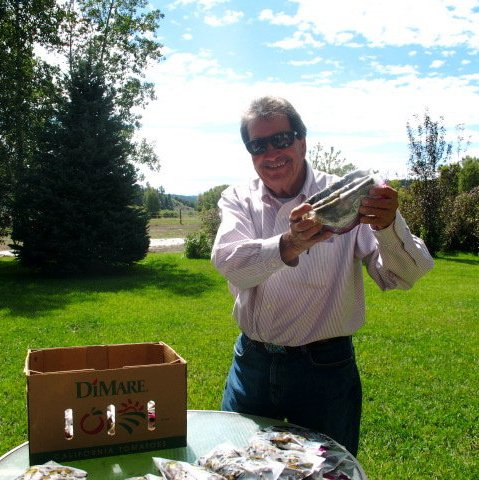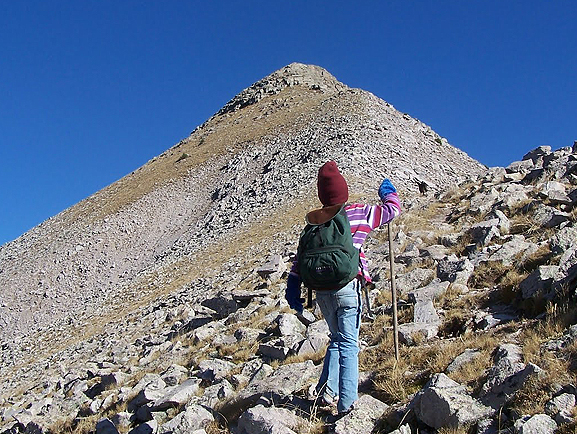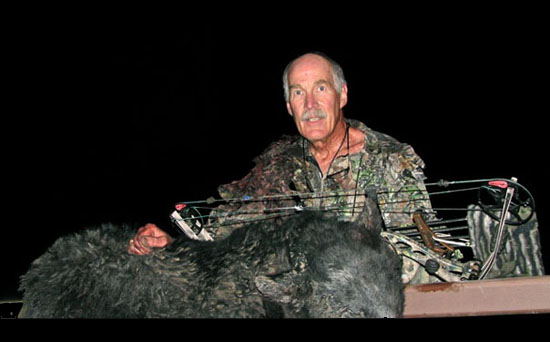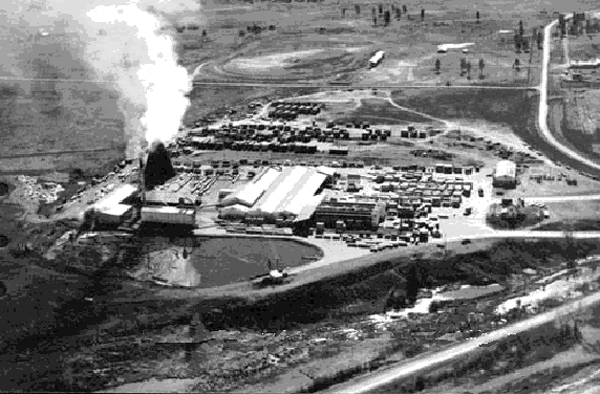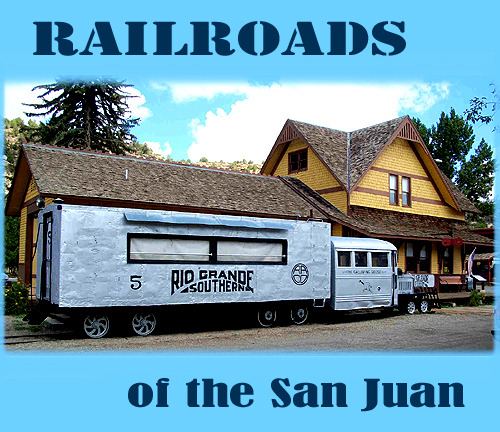Southwest Native American History

by Norm Vance
Early History
There was a time when half of our planet had no human life. Early earth developed with most of the dry land clumped together in one big land mass. Plant and animal life began during this time. Later this landmass broke up into giant pieces, called plates. These plates separated into the geography shown on current world maps. After the separation, human life began in the Eastern Hemisphere and spread to every part of that side of the world. The enormous size of the Atlantic and Pacific Oceans prevented people from populating the Western Hemisphere for a couple of million years.
Then a very special set of circumstances occurred that allowed one of the greatest discoveries in the saga of humankind. The last ice age was a time of planetary change. Moisture from the oceans fell as snow, but because of extra cold temperatures, it did not melt and flow back to the ocean. Huge glaciers built up and covered most of what are now northern Russia and North America. The water, held in snow and glaciers, caused the level of oceans to drop.
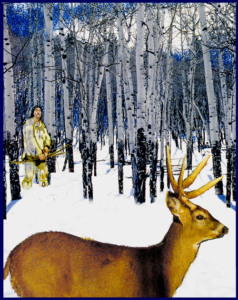 Despite ice age glaciers and extra cold winters, people had migrated to and were living in the northeastern area of Russia. These people were fully developed humans, like us in every physical and mental respect.
Despite ice age glaciers and extra cold winters, people had migrated to and were living in the northeastern area of Russia. These people were fully developed humans, like us in every physical and mental respect.
They were hunters and gatherers as classified by archaeologists, but considering their ice age environment we can guess that hunting and fishing provided their primary food supply.
Although the ice age was in full strength, there were periods of time when cold conditions relented. During these warmer times the ice melted and retreated from some areas. About 35,000 years ago such a time came and lasted for a few thousand years.
Because the ocean level was low the Bering Strait that now separates Russia from Alaska was a continuous ice or land mass. The slightly warm period caused a passageway to form from Russia to Alaska and down a corridor on the eastern slope of the Rocky Mountains. This corridor was an open passage to the glacier’s southern edge near the present At some point during this time a small band of fur covered Asians made a historic trek across the icy connection and down into the Western Hemisphere. This was the great discovery that changed history.
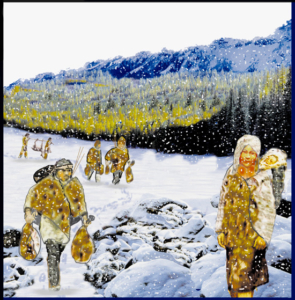 Traditional archaeology writings suggest that these people did not know they made a discovery and that it took many generations for people to slowly move south into the Americas. More recent theories suggest that the migration was quicker, that these people, as bright, curious and alert as any other, made a few observations that would have told them that they had made a discovery. They must have known, by intertribal and trade communication, that the land they left was populated by other people. This new land was markedly different. Each morning they would rise and walk east and south without a trace or sighting of another human. Huge herds of caribou, moose, and elk, along with other animals could be hunted with no competition from other hunters. This new land was obviously different.
Traditional archaeology writings suggest that these people did not know they made a discovery and that it took many generations for people to slowly move south into the Americas. More recent theories suggest that the migration was quicker, that these people, as bright, curious and alert as any other, made a few observations that would have told them that they had made a discovery. They must have known, by intertribal and trade communication, that the land they left was populated by other people. This new land was markedly different. Each morning they would rise and walk east and south without a trace or sighting of another human. Huge herds of caribou, moose, and elk, along with other animals could be hunted with no competition from other hunters. This new land was obviously different.
We could guess that the hunters sent a messenger back to tell the rest of the tribe, that word was then carried to other tribes, and a migration rush was on. It is possible that a single person of curiosity and imagination led a discovery team down the corridor. Every yard south was a step off the edge of the known world.
As they progressed, new discoveries were made; new animals, new plants and an ever warmer environment. Over the 4-5 millennia the passageway was open, many thousands of people made the move to the new world. They traveled into all portions of North America and moved across a second corridor that is Central America and populated South America.
The Asians were fishers and it is possible that some of the migration took place by boat, sailing along the coast. These migrants may have traveled alone or may have moved along with others traveling by land. There is some evidence of this and helps explain how quickly the Asians moved south. There is also some evidence that Asians may have traveled by boats directly across the Pacific, landing both in the northern and southern hemispheres.
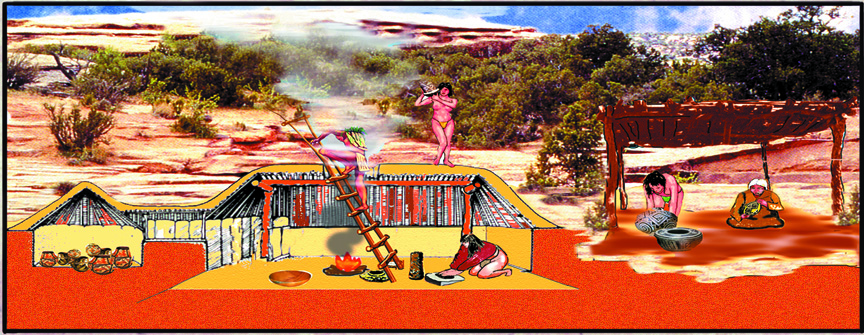
These early centuries in America were amazing times in the history of man. The vastness of the Americas allowed the population to grow generation by generation. In every direction that the people expanded into, new open country and resources were found. By about 12,000 years ago the people known as the Great Hunters were numerous and hungry enough that they hunted two-thirds of the mammalian species on this half of the earth to extinction! These include most large animals including the horse, a beaver the size of a bear, giant bison, woolly mammoths, camels, and others.
The people adapted and made homes in every environment from arctic ice to equator jungles. The population was lightly scattered enough that separate nations or tribes evolved a wide variety of language, culture, religion and society.
The Southwest
By ten thousand years ago ancestors of the new world pioneers we living in the southwestern part of North America. Of interest here is the Colorado Plateau area which is a high elevation plateau just south of the high peaks of the Rocky Mountains.
The people who lived here continued the hunting and gathering nomadic life of their ancestors. They are known as the Clovis and Folsom People. Clovis and Folsom are names of towns in Northern New Mexico close to where the artifacts that identify these people were first found.
Hunters and Gatherers
These people lived simple, but probably contented life. Everything they needed was within their environment. They lived a mobile life, traveling what is called a “seasonal round.” They were ultimately aware of their environment, where the game animals were, and where and when various plant foods and game animals could be harvested according to the season.
They lived in simple structures made of tree branches stacked in dome shapes. Animal skins were lapped over the dome to keep rain out. The skins were transported and new branches gathered at each new campsite.
The early Indians used spears with chipped stone points, chipped stone cutting tools, and stone tools to grind wild grass grain and nut foods into palatable form. They used simple open fire hearths for cooking. They learned weaving with naturally found materials and had both sandals and baskets. They wore animal skins for protection from the weather.
Part of the seasonal round was to go to known places where stone could be found, from which spear points and cutting tools were made. These spear points and tools are the long-lasting artifacts that identify these people.
Hunting any wild game is difficult with a spear, so they hunted in groups corralling animals to make the kill. They may also have used a technique, used by others worldwide during the same era, of driving animals off of cliffs to kill or injure them.
Gathering was fairly easy work. A wide variety of plants like cactus, nuts, and grains were harvested and carried in baskets. Men generally hunted and women gathered. In the evening they met and prepared food. Nuts and grains were ground on a flat stone with a smaller hand held stone. Hunted animals were skinned and cut into cooking size. Camps were usually by rivers or springs for collecting water and washing.
Spark of Civilization
In South America, in the area of Peru, native people began farming around 5-6,000 years ago. It is not yet known if farming technology worked its way north into Mexico or whether farming developed there independently. About 4-5,000 years ago there was primitive farming being done in Mexico.
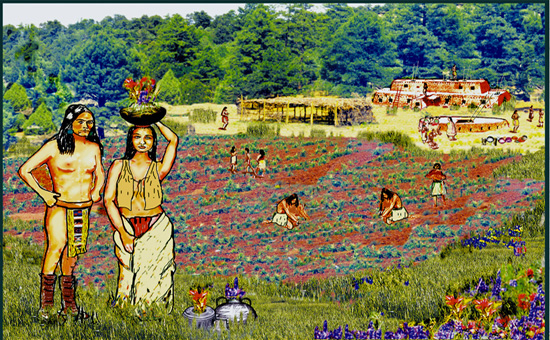
The move to farming caused the people to settle around the farm. This is called to become “sedentary.” With less time on the move, more time was allowed for development of culture and new inventions. These new cultural and engineering ideas spread north. This trend continued for centuries and brought farming and other developments to the people of the southwest and ultimately all Indians north of Mexico.
The Agricultural Revolution
The Indians of Peru and Mexico had long harvested many varieties of wild grasses. The seeds of one must have been extra tasty. This one was harvested and used more than the others. At some point it was noticed that when the seeds were processed at camp, some fell to the ground and later, plants sprouted. Some ingenious individual realized that if the seed was purposefully planted a plot of tasty food grew. They learned to clear the fields of other plants that competed with the planted food. Farming was born.
Over years of planting and harvesting, it was natural to save some of the most robust seed for the next planting. Slowly ever larger grass plants grew with ever-larger seed. Given many generations the plant mutated into a changed and altogether new species. The plants and seeds were larger and the seeds grew in bundles, called cobs. The husk that covered the seed cobs became thick. This thick husk became the key to corn. The wild plant had leaves or husk that opened naturally allowing seeds to fall to the ground to germinate the next season. The new plant had husk that would not open naturally, it had to be purposefully opened and planted. The plant was a “hybrid,” and farmer had to be involved for the species to continue!
It was likely traders, traveling north from Mexico, that brought early corn seed and the technology of farming into the southwest U.S. Over many hundreds of years the technique of growing corn passed from one hunting and gathering tribe to another. It was not a quick revolution.
For many generations, corn was planted at a likely place on the seasonal round. By the time the tribe traveled their circuit and returned there “might be” a crop of sweet, tasty corn waiting for them. The term, might be, was used because this part-time way of farming was less than reliable. Late frost, less rain, insects or animals, or another tribe might destroy or consume the crop before they returned.
In time they realized it would be helpful to have some tribal members stay with the crop. They could protect the crop and insure that it was watered. This was very important because it provided a reason for a permanent camp, a home.
This permanent home base began changing many aspects of life. The seasonal round changed in order for the people to return home more often. When they returned, they brought loads of food.
They knew that food put in a cave spoiled less because of the consistent cool temperature. They realized that if a pit was dug in the earth it had the same effect as a cave. Food could be stored and protected by a pit covering. They used pits when no convenient cave was available. The home base became important as a storage center so many pits were dug.
More people stayed home to manage the ever more complex system and more people at home could grow and manage more crops.
The First House
The exact progression that developed into the first southwest house is not clearly known. It was a slow evolution, as different designs were tried and modified. We can guess that as digging pits into the ground developed, some imaginative person envisioned building a stick and brush dome over the pit to gain extra headroom.
Native people around the world used a simple structure of four upright posts held together at the top by sticks tied from post to post forming a cube shape. They put branches on the top creating shade.
The Anasazi and Puebloans built and used these. The Spanish gave us the name ramada for this structure. At some point, an inventor built a ramada in a large pit and covered the cube with closely layered sticks reaching out to the edge of the pit and then applied mud over the sticks. He or she simultaneously invented the pit house and adobe-covered walls. Adobe is the Spanish word for mud plaster. This was a great moment in southwest architecture for that basic design and adobe has remained a fundamental part of architecture until the present day.
The pit house was never a completely consistent design. New design elements caught on with some tribes, but a fairly consistent evolution in better overall design is seen. In order to have a fire inside, a hole was made in the ceiling to let the smoke out. This hole is sometimes the entryway via a ladder.
After centuries the ramada evolved becoming more substantial with stick walls and then with adobe mud plastering over the sticks. Stones were placed around the bottom of the walls to keep the sticks from sliding out and later stacked stone walls replaced the sticks and mud entirely making a truly substantial building. These pueblos grew in size as the population increased and were used for living space and food storage.
For many centuries the pithouse and pueblo dwellers lived lives of farming and hunting while developing strong religious and cultural beliefs. There were good times and times of stress caused by low rain fall, nomadic tribes raiding the villages and other factors. They moved about from time to time and left many thousands of ruins.
Read about the Chaco Phenomena to continue their story.
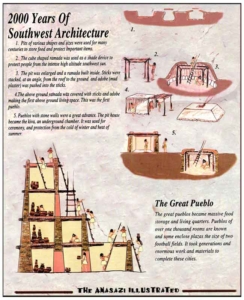
Click Picture to Enlarge

